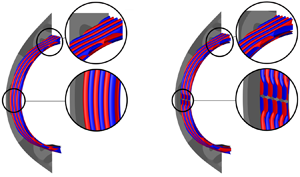Article contents
Hypersonic attachment-line instabilities with large sweep Mach numbers
Published online by Cambridge University Press: 12 March 2021
Abstract

This study aims to shed light on hypersonic attachment-line instabilities with large sweep Mach numbers. Highly swept flows over a cold cylinder that give rise to large sweep Mach numbers are studied. High-fidelity basic flows are obtained by solving full Navier–Stokes equations with a high-order shock-fitting method. Using local and global stability theories, an attachment-line mode is found to be dominant for the laminar–turbulent transition along the leading edge that agrees qualitatively with the experimental observations (Gaillard et al., Exp. Fluids, vol. 26, 1999, pp. 169–176). The behaviour of this mode explains the reason for the transition occurring earlier as the sweep Mach number is above 5. In addition, this attachment-line mode is absent if the basic flow is calculated with boundary layer assumptions, indicating that the influence of inviscid flow outside the boundary layer cannot be ignored as is normally done. It is clearly demonstrated that the global modes display the features of both attachment-line modes, as in sweep Hiemenz flow, and the second Mack modes further downstream along the surface. In the large sweep Mach number regime, the attachment-line mode is inviscid in nature and its growth rate increases with the sweep angle. In contrast, in the lower sweep Mach number regime, the attachment-line instability exhibits the features of viscous Tollmien–Schlichting waves, and the sweep angle first increases but then decreases the maximum growth rate.
- Type
- JFM Papers
- Information
- Copyright
- © The Author(s), 2021. Published by Cambridge University Press
References
REFERENCES
- 6
- Cited by



